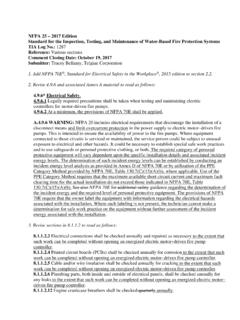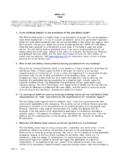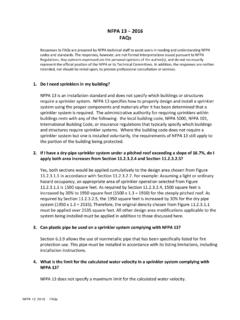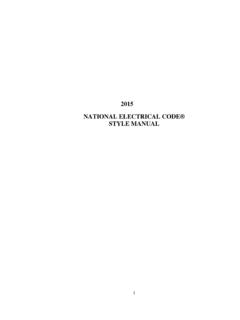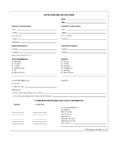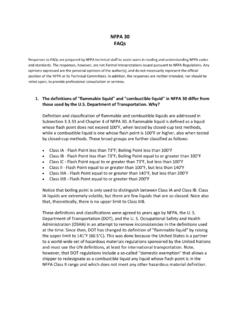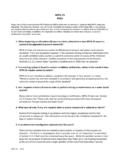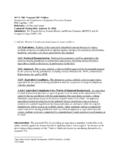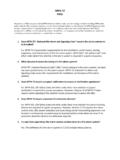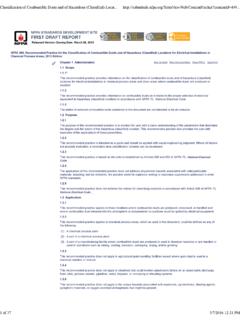Transcription of NFPA 11 Standard for Low-, Medium-, and High-Expansion …
1 Tentative Interim Amendment nfpa 11 Standard for Low-, Medium-, and High-Expansion Foam 2005 Edition Reference: New Chapter TIA 05-1 ( nfpa 11) ((SC 06-3-2/TIA Log 833) Pursuant to Section 5 of the nfpa Regulations Governing Committee Projects, the National Fire Protection Association has issued the following Tentative Interim Amendment to nfpa 11, Standard for Low-, Medium-, and High-Expansion Foam, 2005 edition. The TIA was processed by the Foam Committee, and was issued by the Standards Council on March 21, 2006 with an effective date of April 10, 2006. A Tentative Interim Amendment is tentative because it has not been processed through the entire standards-making procedures.)
2 It is interim because it is effective only between editions of the Standard . A TIA automatically becomes a proposal of the proponent for the next edition of the Standard ; as such, it then is subject to all of the procedures of the standards-making process 1. Revise and as follows: *Scope. This Standard covers the design, installation, operation, testing, and maintenance of low-, medium-, and High-Expansion , and compressed air foam systems for fire protection. It is not the intent of this Standard to specify where foam protection is required. Purpose.
3 This Standard is intended for the use and guidance of those responsible for designing, installing, testing, inspecting, approving, listing, operating, or maintaining fixed, semi-fixed, or portable low-, medium-, and High-Expansion , and compressed air foam fire-extinguishing systems for interior or exterior hazards. Nothing in this Standard is intended to restrict new technologies or alternative arrangements, provided the level of safety prescribed by the Standard is not lowered. 2. Add definitions to chapter 3 as follows: Compressed Air Foam (CAF). A homogenous foam produced by the combination of water, foam concentrate, and air or nitrogen under pressure.
4 Compressed Air Foam Generating Method. A method of generating compressed air foam recognized in this Standard using a mixing chamber to combine air or nitrogen under pressure, water, and foam concentrate in the correct proportions. The resulting compressed air foam is conducted through piping or hoses to the hazard being protected. Compressed Air Foam Discharge Device. A device specifically designed to discharge compressed air foam in a predetermined pattern. Compressed Air Foam System (CAFS). A system employing compressed air foam discharge devices or hoses attached to a piping system through which foam is transported from a mixing chamber.
5 Discharge of CAFS begins with automatic actuation of a detection system, or manual actuation that opens valves permitting compressed air foam generated in the mixing chamber, to flow through a piping system and discharged over the area served by the discharge devices or hoses. A. Hazards that Compressed Air Foam Systems are permitted to protect include the following: 1. Flammable liquids [flash points below 38 C (100 F)] having a vapor pressure not exceeding 276 KPa (40 psia).
6 2. Combustible liquids [flash point of 38 C (100 F) and above]. B. Compressed Air Foam Systems are not permitted to be used on the following fire hazards: 1. Polar solvents. 2 Chemicals, such as cellulose nitrate, that release sufficient oxygen or other oxidizing agents to sustain combustion. 3. Energized unenclosed electrical equipment.
7 4. Water-reactive metals such as sodium, potassium, and NaK (sodium potassium alloys). 5. Hazardous water-reactive materials, such as triethyl-aluminum and phosphorous pentoxide. 6. Liquefied flammable gas. 3. Add a new Class C as follows: Class C. Fire that involves energized electrical equipment where the electrical resistivity of the extinguishing media is of importance.
8 4. Revise current section as follows: Plans shall include or be accompanied by the following information, where applicable: 1) Physical details of the hazard, including the location, arrangement, and hazardous materials involved. 2) Type and percentage of foam concentrate. 3) Required solution application rate. 4) Water requirements. 5) Calculations specifying required amount of concentrate. 6)* Hydraulic calculations. 7) Calculation specifying required amount of air. 8) CAFS flow calculations report. 9) Identification and capacity of all equipment and devices.
9 10) Location of piping, detection devices, operating devices, discharge devices, and auxiliary equipment. 11) Schematic wiring diagram. 12) Explanation of any special features. 5. Insert a new Chapter 7 and renumber existing chapters 7 through 11 to chapters 8 through 12 as follows: Chapter 7 Compressed Air Foam Systems General. This chapter shall provide requirements for the correct use of compressed air foam system components. All components shall be listed for their intended use. Where listings for components do not exist, components shall be approved.
10 Water Supplies. Quality. The water supply to compressed air foam systems shall be permitted to be hard or soft, fresh or salt, but shall be of a quality so that adverse effects on foam formation or foam stability do not occur. No corrosion inhibitors, emulsion breaking chemicals, or any other additives shall be present without prior consultation with the foam concentrate supplier. Quantity. The water supply shall be of a quantity to supply all the discharge devices and compressed air foam hoses that shall be permitted to be used simultaneously for the specified time.
